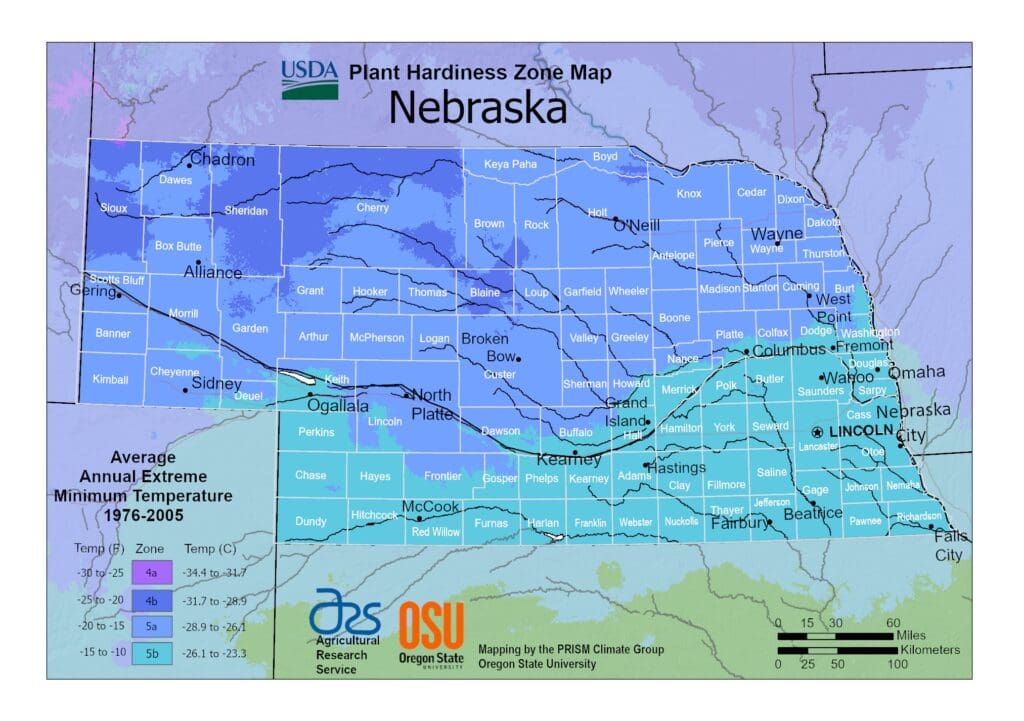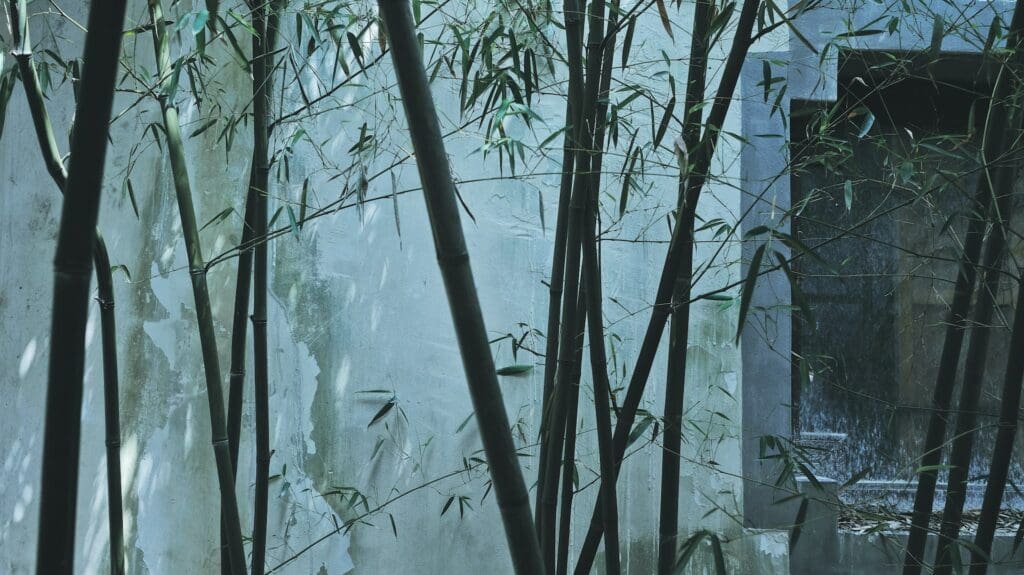Growing Bamboo In Nebraska
Growing bamboo in Nebraska can be a challenging endeavor due to the state’s climate and soil conditions. However, with careful cultivation and consideration of suitable cold hardy bamboo species, it is possible to successfully grow this versatile plant in certain parts of Nebraska.
Key Takeaways
- Bamboo can be successfully grown in Nebraska with proper care and attention.
- Cold-hardy, clumping bamboo species like Fargesia nitida are recommended for Nebraska.
- Growing bamboo in Nebraska requires careful cultivation due to climate and soil conditions.
- Research local rules and regulations before planting bamboo, as some states and cities have restrictions on growing invasive plants.
Hardiness Zones and Climate
Nebraska’s diverse hardiness zones and challenging climate present unique considerations for successfully growing bamboo in the state. With USDA Plant Hardiness Zones of Nebraska falling in zone 4 and zone 5, the state experiences cold winters and hot summers.

To ensure successful bamboo growth, winter watering is crucial as it helps prevent dehydration caused by dry air and frozen soil. Additionally, proper containment is essential to prevent bamboo from spreading uncontrollably and becoming invasive.
Suitable Bamboo Species
The selection of appropriate bamboo species for cultivation involves considering factors such as hardiness, growth habit, and desired aesthetic qualities. It is important to choose cold-hardy bamboo options that can withstand the state’s harsh winters. Here are four key considerations when selecting bamboo species:
1) Cold hardiness: Choose bamboo species that are known for their ability to tolerate low temperatures and survive in USDA hardiness zones 4 to 6.
2) Growth habit: Consider whether you prefer clumping or running varieties of bamboo. Clumping bamboos are recommended as they are easier to contain and require less maintenance than running bamboos.
3) Maintenance requirements: Look for bamboo species that have lower maintenance requirements, such as resistance to pests and diseases, as well as drought tolerance.
4) Aesthetic qualities: Select bamboo species that fit your desired landscape design, whether you want tall and graceful plants or shorter varieties for borders and ground covers.
By carefully considering these factors, you can choose suitable bamboo species that will survive in Nebraska’s climate while meeting your specific garden or landscaping needs.
Three of the most cold-hardy bamboo species are:
- Phyllostachys nuda: Also known as the “Naked Bamboo,” this species is native to China and can tolerate temperatures as low as -10°F (-23°C). It has a dense, upright growth habit and is often used for screens, hedges, or as a standalone specimen.
- Phyllostachys bissetii: Originating from China, this species is highly cold-tolerant and can withstand temperatures as low as -10°F (-23°C). It forms a dense, upright clump and is commonly used for privacy screens or as a windbreak.
- Fargesia nitida: Native to the mountains of China and Tibet, Fargesia nitida is one of the most cold-hardy bamboo species. It can endure temperatures as low as -20°F (-29°C) and maintains an attractive, upright growth habit. This species is often utilized for hedges or as an ornamental plant in gardens.
Choosing the Right Planting Spot
When selecting a suitable location for planting bamboo, it is crucial to consider factors such as sunlight exposure, soil conditions, and proximity to structures or other plants.
Bamboo requires a planting spot that receives full sun or partial shade throughout the day. It thrives in moist soil with good drainage and high organic content. Avoid areas with compacted or waterlogged soil, as this can lead to root rot and stunted growth.
Additionally, choose a location that provides ample space for the bamboo to spread without causing damage to nearby structures or competing with other plants for resources. Adequate spacing will also allow for proper air circulation around the plants, reducing the risk of fungal diseases.
Preparing for Winter Conditions
To ensure the survival of your bamboo during the harsh winter months, it is essential to take proactive steps in preparation for the challenging weather conditions.
Winter watering is crucial for maintaining the health of your bamboo plants. Even though they may be largely dormant, they still require moisture to sustain their root systems. It is important to water deeply and thoroughly before the ground freezes to provide adequate hydration.



In addition to winter watering, preventing snow damage is vital for preserving the integrity of your bamboo plants. Heavy snow can weigh down on the culms and cause them to bend or break. To prevent this, gently shake off any accumulated snow from the bamboo plants. Leaving heavy snow on them for an extended period can result in permanent damage.
Lastly, assessing plant health is necessary during winter months. Take note if any culms have died or if there are signs of disease or pest infestation. Prune away any dead or damaged culms and address any issues promptly to maintain optimal plant health.
Mulching for Winter Protection
Mulching during the winter months provides essential protection for bamboo plants in cold climates. Insulating techniques such as mulching help regulate soil temperature and moisture levels, which are crucial for the survival of bamboo during freezing temperatures.
When selecting mulch types, it is important to choose organic materials that are well-draining and can retain moisture. Examples include straw, wood chips, or shredded leaves. These materials create a protective layer over the soil, insulating the roots from extreme temperature fluctuations. Mulching also helps prevent frost heaving, which can damage bamboo roots.



Additionally, winter watering is necessary to ensure that bamboo plants receive adequate moisture during dry periods when natural precipitation may be limited. Watering deeply before applying mulch helps maintain soil moisture throughout the winter season and promotes healthy growth in spring.
Protecting Bamboo from Cold Winds
Protecting bamboo from cold winds requires strategic placement near natural barriers or the use of physical structures to create windbreaks. This is crucial in order to shield the bamboo plants from the drying and damaging effects of strong winter winds.
Here are some insulating techniques and windbreak strategies that can be employed:
-
Planting bamboo near existing structures such as fences, buildings, or trees can provide natural protection against cold winds.
-
Creating artificial windbreaks using materials like screens, fabric, or temporary fencing can effectively reduce the impact of strong gusts on the bamboo plants.
-
Applying mulch around the base of bamboo can help insulate the roots and protect them from freezing temperatures.
Additionally, it is important to ensure proper winter watering for bamboo. Although they may appear dormant during winter, providing adequate moisture is essential to prevent dehydration and maintain overall plant health.
Container Growing in Freezing Temperatures
Container gardening in freezing temperatures requires careful selection of cold-hardy plants and proper insulation techniques to protect the roots from frost damage.
When it comes to growing bamboo in containers during winter, there are some important winter care tips to keep in mind.
Firstly, choose a cold-hardy bamboo species that can withstand freezing temperatures. Phyllostachys bamboo species are known for their ability to survive in cold climates.
Secondly, consider bringing the container indoors during extreme freezing conditions or placing it in a sheltered area such as a garage or shed. This will provide additional protection against the harsh elements.
Lastly, mulch generously around the base of the bamboo plant to insulate the roots and retain moisture.
Winter Care and Maintenance
As Nebraska experiences cold winters with snow and frozen soil, it is essential to take measures to protect bamboo plants from potential damage. One important consideration is preventing snow damage to bamboo by shaking off accumulated snow and not attempting to break off frozen snow or ice, which can harm the plant.
Additionally, assessing dying outdoor bamboo is necessary to identify any issues and implement appropriate remedies. This may involve examining the overall health of the plant, checking for signs of disease or pests, and adjusting care practices accordingly.
Conclusion
In conclusion, growing bamboo in Nebraska can be challenging due to the state’s climate and soil conditions. However, with careful cultivation and proper selection of cold-hardy bamboo species, it is possible to successfully grow bamboo in certain parts of Nebraska.
By planting bamboo in well-draining soil, providing consistent moisture and sunlight, and insulating the plants during winter, gardeners can protect their bamboo from the cold temperatures.
Despite the challenges, growing bamboo in Nebraska can offer various benefits such as privacy, shade, and support for local biodiversity and ecosystems.

